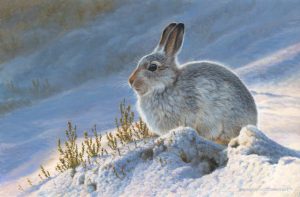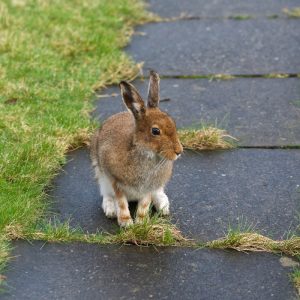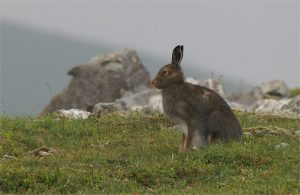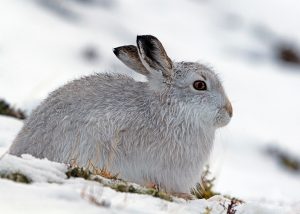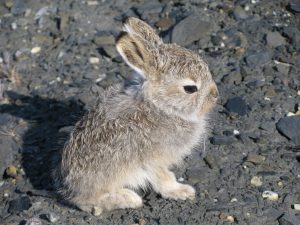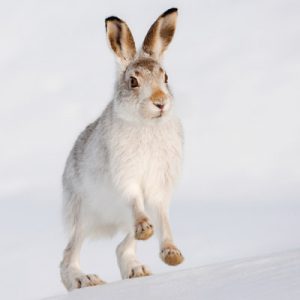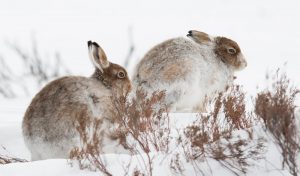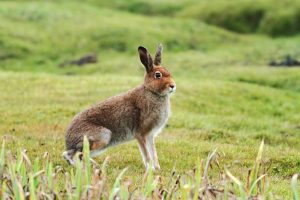Mountain Hare
The mountain hare is one of the most widely distributed of the hare species. It is also one of the largest, second only to the European hare. It is highly adapted for the snowy mountainous regions that it inhabits.
Scientific Classification
| Kingdom | Animalia |
| Phylum | Chordata |
| Class | Mammalia |
| Order | Lagomorpha |
| Family | Leporidae |
| Genus | Lepus |
| Scientific Name | Lepus timidus |
Quick Information
| Other Names | Irish Hare, Variable Hare, White Hare, Tundra Hare, Blue Hare, Snow Hare, Alpine Hare |
| Subspecies | 15 recognized subspecies including the Irish mountain hare and the Scottish mountain hare |
| Size | 18-26 inches (45-65 cm); tail length is 1.6-3.1 inches (4-8 cm). |
| Weight | 5.5-8.8 lbs (2.5-4 kg); females are heavier than males |
| Color | Summer: Various shades of brown
Winter: Molts into a white colored coat |
| Distribution | From Poland to the Pacific Ocean in the east, Scotland, Ireland, England, the Faroe Islands and the Alps |
| Habitat | Boreal forests through most of their range; also in heather moorlands, mountain grasslands, forestry plantations, and dry rocky hills |
| Communication | Primarily through touch; scents are also used |
| Lifespan | 9 years on average in the wild |
| Diet | Summer: Forest inhabitants eat leaves and twigs, those in the tundra consume alpine plants
Winter: Mostly eat heather |
| Adaptations |
|
| Breeding Season | Between February and August |
| Gestation period | 50-54 days |
| Litter Size | 1-5 |
| Diseases | Tick and Trichostrongylosis retortaeformis, a gut parasite |
| Predators | Eurasian eagle-owls, red foxes, stoats, and golden eagles |
| IUCN Conservation Status | Least Concern |
Behavior
Mountain hares are nocturnal and solitary animals. Despite their solitary nature, they have been known to eat in groups of up to 70 individuals, especially during difficult weather conditions.
Their home ranges are between 80 to 100 hectares. Being saltatorial, their main method of locomotion is through leaping and hopping; a threatened individual can reach speeds of more than 60 km/h whilst hopping away.
Mating and Reproduction
During the breeding season, a female may be pursued by many males, but if the former is not in heat it may drive the suitors away by scratching or showing its back towards them with the ears laid back.
A female may have 2-3 litters in a year. Litter size varies with the size of the mother, and a larger female is capable of having a bigger litter than a smaller-sized female mountain hare.
Life Cycle
Infants, or leverets, are born with a weight of around 0.20lb (90gm), with fully developed fur and opened eyes. Suckling begins immediately after birth and weaning takes place after a month. Mothers leave their wards by themselves for most of the time, occasionally returning to the burrows only to feed and suckle her young.
Interesting Facts
- The Arctic hare used to be considered as a subspecies of the mountain hare, but it has now been segregated into a distinct species.
- There are sometimes fraternal associations between mountain hares, but females do not develop relations with each other.
- Before getting into its burrow to rest, a mountain hare jumps around it own tracks to lay down footprints to confuse predators. This uncanny behavior is called ‘hooking.’
References
- https://en.wikipedia.org/wiki/Mountain_hare
- https://www.onekindplanet.org/animal/mountain-hare/
- https://www.iucnredlist.org/species/11791/45177198
- https://animalia.bio/mountain-hare
- http://animaldiversity.org/accounts/Lepus_timidus/#lifespan_longevity
- https://www.gwct.org.uk/research/species/mammals/mountain-hare/
Published on August 26th 2016 by Sudipto Chakrabarti under Coniferous Forest Animals.
Article was last reviewed on 26th June 2023.


